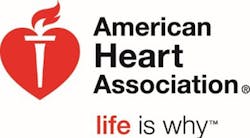AHA Recommends Standards to Improve Dispatcher-Assisted CPR
The American Heart Association – the world’s leading voluntary health organization devoted to fighting cardiovascular disease – published recommendations this month that set standards for timely and high quality delivery of dispatcher-assisted CPR, also known as telephone CPR (T-CPR). The recommendations are accompanied by performance goals to measure successful implementation by first responders.
To generate discussion among professionals engaged in improving survival from cardiac arrest, the program and associated metrics are open for public comment. The AHA will be accepting comments from interested parties through the website cpr.heart.org/PublicComment until November 16, 2016.
Every year more than 350,000 people suffer out-of-hospital cardiac arrest (OHCA) in the United States with just a 12 percent survival rate in 2016. Early access to 911 and early CPR are the first two links in the chain of survival from cardiac arrest. Currently, less than half of those who suffer an OHCA receive bystander CPR.
“The most immediate way to improve survival from cardiac arrest is to improve bystander CPR rates,” said Michael C. Kurz, MD, MS, FACEP, FAHA, Associate Professor, Department of Emergency Medicine, University of Alabama at Birmingham and volunteer chair of the T-CPR Taskforce for the American Heart Association. “Providing telephone CPR saves lives by providing just-in-time bystander CPR instructions. When T-CPR instructions are not provided, preventable deaths from out-of-hospital cardiac arrest occur.”
The AHA recognized the need for emergency response dispatchers to be trained to provide telephone CPR instructions prior to the arrival of EMS in the 2010 AHA Guidelines for CPR and ECC, and this was reiterated in the Guidelines most recently updated in 2015. As much as 50 percent of bystander CPR in communities that provide T-CPR instructions to 911 callers is directly attributable to those instructions.
AHA’s six program recommendations stress ongoing training and continuous quality improvement:
- Commitment to T-CPR by both the emergency communications center and the dispatch center director
- Train and provide continuing education in T-CPR for all telecommunicators
- Conduct ongoing quality improvement for all calls in which a cardiac arrest in confirmed by EMS personnel and in which resuscitation is attempted
- Communication between the emergency communications center and responding EMS agencies to measure implementation and effectiveness
- Designated medical director to issue protocols and work closely with the responding EMS agencies
- Recognition for outstanding performance
“In telephone CPR, the dispatcher and the caller form a team in which the expertise of the telecommunicator, combined with the willingness of the caller to assist, strengthen the first two links in the chain of survival,” said Kurz.
The program recommendations are accompanied by a series of five performance metrics:
- Percentage of OHCA cases correctly identified by the dispatcher
- Percentage of correctly identified OHCA cases that were deemed recognizable versus those that were not because of complicating factors (e.g., language barriers, caller hang-up, CPR already in progress)
- Percentage of victims who receive T-CPR
- Median time between 911 call and recognition by dispatcher of cardiac arrest
- Median time between 911 call and first T-CPR directed chest compressions
Following the public comment period, the AHA will update the program and performance recommendations. The final document will be published online along with a comprehensive guide to implementing T-CPR at the community level.
About American Heart Association
The American Heart Association is devoted to saving people from heart disease and stroke – the two leading causes of death in the world. We team with millions of volunteers to fund innovative research, fight for stronger public health policies, and provide lifesaving tools and information to prevent and treat these diseases. The Dallas-based association is the nation’s oldest and largest voluntary organization dedicated to fighting heart disease and stroke. To learn more or to get involved, call 1-800-AHA-USA1, visit heart.org or call any of our offices around the country. Follow us on Facebook and Twitter.
